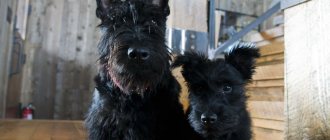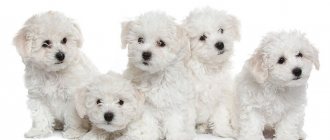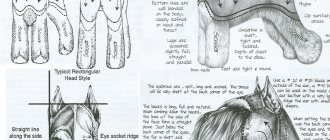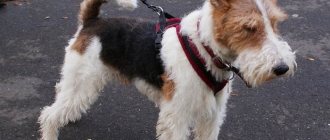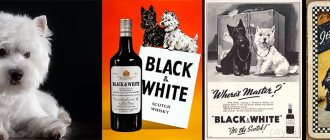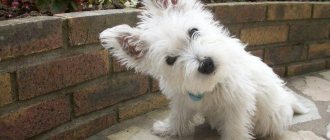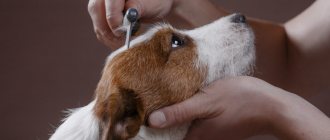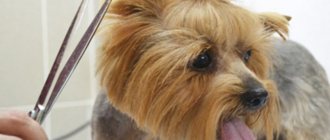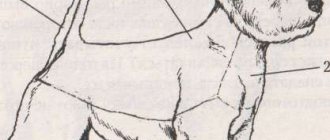Scotch Terriers are small dogs whose main purpose was previously to hunt burrowing animals and rodents. However, over time, Scottish terriers were practically no longer taken for hunting, relegating them to the role of pets and exhibition participants. But in order for their pets to take prizes, owners have to work hard on their appearance.
Features of grooming a Scotch Terrier
Today, grooming is in the nature of daily pet care.
Dog grooming can be done at home or in the salon according to the location, and according to the purpose: everyday and show. Home grooming means that the owner of the animal independently performs all the procedures for caring for his pet at home.
Salon grooming means that the owner of the animal performs grooming procedures in the salon; these services are performed by a specialist.
Most often, animals with complex grooming are brought to the salon, which involves cutting or trimming using special professional tools and equipment.
Everyday grooming is aimed at maintaining a healthy appearance of the animal. The task of exhibition grooming is to use the skillful actions of the master to hide the shortcomings of the animal’s structure and emphasize its advantages, taking into account the trends and trends in fashion of a certain type and breed of animal.
The most common procedure for which dog and cat owners go to the salon today is dog grooming. To trim a dog, you need to carry out a procedure that involves reducing the length of the coat and giving it a certain shape.
But we must remember that there are a number of animals whose breed feature is wool trimming. Trimming is the removal of mature hair, which consists of artificial shedding by human hands, in which the guard hair is removed from the root.
This procedure is quite complex and requires certain knowledge and skills.
Trimming is an integral part of caring for wire-haired dogs (because these animals do not have a pronounced natural shedding) of breeds such as schnauzers (Middle Schnauzer, Giant Schnauzer, Miniature Schnauzer), griffins (Belgian and Brussels), various types of terriers (Scotch, West, Fox, Irish, Welsh, Cairn, Airedale, Jack Russell and others).
The Scottish Terrier or Scottish Terrier was once a very popular breed of dog in our country. The breed is quite difficult to care for, as it requires certain skills and a fairly developed aesthetic taste. People who have no knowledge or experience should not undertake this, but should seek advice from a breeder or professional groomer. We have such specialists in our veterinary center.
For salon grooming of a Scotch Terrier, we will need the following tools: a comb with short and long teeth, a slicker brush, various trimming knives, several types of hairdressing scissors, strippers, an electric clipper, a nail clipper, an electric hair dryer compressor, as well as a number of cosmetics: ear lotion , trimming powder, shampoo and coat conditioner.
Rules for grooming a Scottish Terrier
As a rule, dog grooming consists of several stages:
- unraveling decorative fur on the chest, paws, beard;
- removal of undercoat;
— trimming of mature guard hairs;
- Grooming the Scotch Terrier (cutting with scissors and clippers decorating the fur;
- ear cleaning;
- nail trimming;
- washing and drying wool.
The terrier's adhesive tape decorates the hair and forms a beard and bangs on the head, a skirt on the animal's body, and pants on the legs. This coat is longer than the coat on the body and therefore requires regular brushing. It is advisable to comb the decorative coat with a long-toothed comb once every 2-3 days, without leaving any tangled hairs.
Before you trim your dog, remember that trimming a Scotch Terrier is not done at the request of the owner and groomer, and technically it can only be done when the animal’s guard hair is mature (i.e. the hair can be easily removed by hand).
As a rule, Scotch Terrier trimming is done once every 4-6 months (about 2-3 times a year). In the interval between trimming, in order to maintain a beautiful aesthetic appearance, dogs of this breed undergo a cosmetic haircut, the essence of which comes down to giving shape to the decorative coat.
Thus, dogs of the Scottish Terrier breed need to have their hair cut or trimmed approximately once every 2-3 months.
Caring for the eyes and ears involves monitoring the condition of these organs and, if necessary, removing contaminants.
If the amount of discharge from these organs has increased sharply or you notice an uncharacteristic and unpleasant odor, you should consult a veterinarian.
After examining and identifying the causes, the specialists of our veterinary center will decide on further treatment and give you qualified advice on this problem.
Due to the nature of the coat, the Scotch Terrier needs to be washed in several stages. The first step is to wash the animal with a cleansing shampoo to remove all contaminants from the animal’s fur and skin. At the second stage, you can wash it with a special shampoo for coarse dogs (this shampoo will give the coat the hardness of the breed).
At the third stage, you need to apply a balm or conditioner to the long decorating wool, which will remove static tension from the wool, make the hair more elastic and elastic (will help preserve the hair in the future, this wool will tangle less).
You should wash your pet only after you have combed the entire animal and there is not a single tangled hair on your pet’s body. Be sure to dry your dog completely after washing. You need to dry your Scotch Terrier with a hairdryer at a temperature that is comfortable for the dog. The animal must be accustomed to the drying procedure from childhood.
The sooner you teach your dog to adequately perceive a hair dryer, the more comfortable and enjoyable this procedure will be in the future.
If you and your pet are planning to visit an exhibition, then you need to remember that preparation of the coat for this important event begins 12 weeks in advance and consists of several stages of wool processing, taking into account the individual structural features of the animal; the dog must be cut in advance. For show grooming of a Scotch Terrier, you need to contact a breed groomer who knows in detail all the trends in the breed, taking into account the requirements of canine fashion.
Grooming a Scotch Terrier at Vetmaster
Today, the veterinary can offer you a full range of veterinary and grooming services for your Scotch Terrier in the Ramensky district, the cities of Ramenskoye and Bronnitsy. The salon master works by appointment, and you can make an appointment with a specialist by calling the veterinary center.
Our specialists are confident that the sooner your animal becomes familiar with hygiene procedures, the easier it will be to perform them, while grooming dogs will bring pleasure to the owner and pet. Remember that the beauty and health of your pet is in your hands and a beautiful animal, first of all, must be healthy!
Source: https://vetmaster.ru/grooming-skotchterjera/
Character and behavior
The character of this dog changes noticeably over the years. As a child, Scotch Scotch is very active, he loves to play around and frolic, and can be naughty. However, after 1–2 years he becomes reserved and displays “that very” “British” character, which is characteristic only of a real British gentleman.
The dog emphasizes in every possible way that he is purebred, i.e. has a noble origin. Therefore, he does not like to communicate with other dogs and animals in general in the house. But Scotch loves to play and listen carefully to all members of the household, showing his best qualities - nobility, loyalty, cheerfulness.
Despite its average size, the Scottish Terrier can cope with the tasks of a watchdog. He will protect his owner without hesitation and may even show aggression towards strangers. This is why it is highly undesirable to keep other animals in the house together with the Scottie.
Scotch is very sociable, but not intrusive. It can easily spend the whole day alone if the owner is away on business. In general, the Scot loves a measured lifestyle and long but calm walks. A dog of this breed is perfect as a companion and constant companion for the whole family.
This is interesting. Over the course of several centuries, the terrier has changed, but it has not lost its hunting instincts. Therefore, the dog will gladly take part in burrow hunting and can become an excellent rat catcher.
Scottish Terrier
Trimming is the plucking of dead hairs, which helps renew the dog's hair. Artificial shedding. The master trims the dogs using various tools.
How often is trimming needed?
The frequency of visits is from 2 to 6 times a year. Your groomer will tell you how often you should pluck.
How to independently understand that it’s time for trimming?
It is enough to pull the hair on the back; if the hair comes off, then it’s time to take the dog to the salon.
What is rolling?
Rolling is layer-by-layer plucking of wool (removal of mature long hairs. Formation of 2-3 layers of wool.
How often is rolling needed?
Rolling for show dogs, regular visits - every 10-15 days. Rolling for domestic dogs—visit regularly: every 1.5-2 months
Is it possible to alternate between trimming and cutting?
This is not recommended. Haircuts change the structure of the coat, it becomes soft. However, after 7-8 years of trimming, the dog can be trimmed without fear; the structure of the coat will not change.
At what age should you start trimming?
The first trimming should be done when the puppy is 3-4 months old. After the last vaccination and quarantine 10-14 days. Only the puppy's hair is plucked. Due to his age, mobility, delicate and vulnerable psyche and delicate skin, the puppy may feel discomfort during trimming. But each time, your puppy will get used to the procedure.
Do I need to do anything to the hair between treatments?
It is necessary to comb out the undercoat by stripping or trimming (the groomer should tell you about this in detail, it is also necessary to comb out tangles. Well, visit the salon for washing and drying.
To cut or trim?
1.2 clipper haircuts can completely change the structure of the coat! It is almost impossible to restore such hair (painful for dogs); in rare cases, the hair is restored, but it takes up to 6 months and very large material costs (regular visits to the salon)
Does your dog experience pain during trimming?
The dog does not experience pain or discomfort during trimming! We pluck only dead and mature hairs
Why does the trimming procedure take so long?
The procedure for first trimming a puppy takes from 2 to 4 hours, it is always a labor-intensive process and requires more time. The puppy's first fur is plucked by hand, breaks are required for the puppy to get distracted, relax and play. The puppy has a very delicate and vulnerable psyche, plucking occurs little by little and slowly.
The trimming procedure for an adult dog takes on average from 1 to 6 hours, depending on the breed of the dog and the frequency of visits to the salon (full trimming, regular rolling, show rolling)
In what cases is it better to refuse trimming?
- After 2-3 clipper haircuts, it is advisable to give up trimming; the hair restoration procedure is very painful for the dog and practically impossible.
- If your dog has allergic skin rashes (dermatitis), trimming will worsen the condition.
- After 7-8 years of trimming, we recommend cutting your dog with a clipper.
- Some dogs naturally have a (genetically determined) soft, curly coat
- Subtle and vulnerable sensitivity and intolerance to trimming! (causes discomfort and pain
We do not recommend trimming dogs during heat.
Price
Service Price Time approximate
| Complex (regular TRIMMING every 2 months) | 2000 | 2 hours 30 minutes |
| Trimming complex | 2500 | 3 hours 30 minutes |
| Complex haircut (full 0.5 mm) | 1500 | 2 hours |
| Complex with clipper back trim with breed lines | 1700 | 2 hours 30 minutes |
| Washing – drying up to 4 cm length of wool including hygiene | 1200 | 1 hour 30 minutes |
Additional services
Name Price
| Flea removal/tick removal | 300 |
| Shaving “poodle paws” | 300 |
| Combing tangles if their number exceeds more than 20% of the wool mass | 700 rub/hour |
Departures Price
| Nizhny Tagil | 500 |
| out of town at a distance of | |
| 30 km | 1000 |
| 70 km | 2000 |
| Pick up your pet from your home and bring it back after grooming | 800 |
Source: https://felix-groom.ru/grooming-po-porodam/skotch-terer
Trimming in a veterinary clinic
Professional hair care for your pet will be provided by the Moscow veterinary clinic "Panvet". The most difficult thing in the procedure is, perhaps, just its organization. In order to use the services of a groomer, you will need to make an appointment in advance and try not to miss the appointment time. Everything else will be done without your participation: the dog’s coat will be quickly moistened, combed, divided into separate strands and carefully trimmed, in accordance with the rules adopted for Scotch Terriers.
Scottish Terrier - maintenance and care at home
The breeds of modern dogs are very diverse and a potential owner can choose any pet based on his taste and budget. Those who love miniature companions will surely love the Scottish Terrier. What are these four-legged creatures?
Description and characteristics of the breed
Before getting a pet from the shores of Scotland, it would be useful to study the description of the breed and the characteristics of caring for these animals.
The Scottish Terrier is a small, cute dog that is often called the Scottish Ground Dog or the Scottish Terrier. Such animals are also called little gentlemen due to the somewhat comical solidity given to the dog by his mustache and eyebrows. And although the size of Scotch Terriers is small, their body is still quite strong, and their paws, although short, are powerful.
The good-natured character of the Scotch Terrier, however, borders on stubbornness, often turning into outright mischief. At the same time, Scottish terriers are quite reserved towards strangers, and in general during walks they most often demonstrate an independent appearance, full of their own dignity.
But the roots of these dogs go back centuries, when their ancestors pulled weasels and foxes out of deep holes with loud barks. For this reason, today Scottish Terriers are not at all alien to hunting instincts.
While walking sedately through the park, a pet may react violently to a passing cat or a running rodent, quickly rushing forward with the intention of punishing the impudent one.
Based on the described characteristics, the Scotch Terrier can be called a devoted and very intelligent companion, whose behavior, however, needs some adjustment and full training.
Origin story
Modern dog handlers cannot reliably determine how the Scotch Terrier breed was produced. There is an opinion that farmers and foresters in Scotland contributed to the process of breeding the dogs. However, the last hypothesis is at the level of assumptions, since there is no documentary evidence of this fact.
However, Scotland is called the homeland of these funny animals. Also, some researchers are confident that the ancestors of the Scottish Terrier first appeared in the vicinity of a Scottish town called Aberdeen. Such animals had a funny tail, a long abdomen, and were covered with short, stiff hair that was brindle in color.
For many years and even centuries, Scottish terriers were the name given to almost all dogs in the United Kingdom. Over time, however, selection did its job and the differences between the so-called burrow dogs became obvious. After several exhibitions at the end of the 19th century, the name of the breed was assigned to the Scotch Terrier, and in 1879 the official breed standard was described.
They gained enormous popularity in the 40s of the 20th century. The dogs were included among their favorites by such outstanding personalities as President Roosevelt, Charlie Chaplin, Albert Einstein and others. Soviet celebrities did not lag behind them.
What is Vladimir Mayakovsky worth alone with his pet named Skotik. Nadezhda Rumyantseva even kept 17 dogs of this breed that performed in the circus. Writers love them too. Thus, Scotch terriers found a place on the pages of the works of Kipling, Virginia Woolf, and others.
Incredibly charming Scots even decorated Finnish postage stamps with their images!
Breed standard and puppy selection
When choosing, you should rely on the standard developed in 1998. Thus, purebred individuals must have a head proportional to the height of the animal. The Scotch Terrier's skull is wide but flat. The nose and teeth are neat, the bite is correct. The upper teeth should be perpendicular to the lower jaw and cover it tightly.
The eyes are wide-set, almond-shaped, and usually have a dark brown tint. The rounded erect ears are not set too close to each other. The neck is of medium length, quite muscular. The back is short and massive, as is the loin. The ribs are rounded, the tail is thick at the base, gradually tapering towards the end, straight or slightly curved in shape.
The front legs are slightly larger than the hind legs.
Characteristic:
- The Scottish Terrier's coat fits tightly to its body and has a soft undercoat.
- The Scotch Terrier's movements are smooth and free.
- The weight of an adult is 8.5-10.4 kg, body height at the withers is 25.4 - 28 cm.
- The standard color of the animal is black, matte or brindle.
A potential owner should consider some recommendations when choosing Scotch Terrier puppies:
- Scotch Terrier puppies are curious, fearless, and active.
- During the selection process, it may be difficult to determine the puppy's health status. The fact is that most genetic diseases may not appear until the age of six. Only in three-month-old puppies can deafness or obvious developmental pathologies be determined.
- When choosing a Scotsman as a home companion, it is enough to turn to pet-class individuals, which allows you to purchase a purebred animal for relatively little money.
- If the purchased Scotch Terrier is subsequently to become the owner's assistant on the hunt, the manufacturer must provide documents confirming that it has passed working tests.
- When purchasing a puppy for subsequent breeding, you should carefully check the complete package of documents of the animal.
In some cases, sellers recommend that the buyer not make a pedigree in order to save money. However, even if this information is missing, documentary evidence of the initial inspection must be available. Absolutely all planned matings must be recorded in kennel clubs.
Features of keeping a dog
For Scotch Terriers, both a private house and an apartment are equally suitable as a place to keep them. However, we should not forget that these dogs have a very strong desire to dig tunnels. Therefore, there is a high risk of attacks from a miniature hunter in the area around the house.
The home must provide a personal area for tape. There should be a place to sleep and a corner with bowls and toys. Since Scottish Terriers are very mobile and active animals, it is necessary to provide them with moderate physical activity. It is better to walk dogs twice a day.
But due to their small size, dogs are not intended for long promenades. The Scotch Terrier should be walked on a leash, since a dog that smells the smell of game while walking through a forest or meadow will forget about everything in the world.
Only adult animals should be released from a leash, making sure that the place is sufficiently safe, and that the dog always returns to the owner when called and does not enter into fights with other animals.
Care and feeding
Caring for a Scottish Terrier is not as difficult as it might seem. The main areas of care are claws, teeth, eyes, ears and, of course, fur.
A thick, long coat needs regular washing several times a month. It is recommended to choose proven, high-quality shampoos and conditioners produced for bathing wire-haired dogs.
After taking water procedures, the tape can be wiped with a towel. Since a dog's fur can quickly grow and mat, it is necessary to trim it in a timely manner. However, only pets can carry out the procedure on their own. Exhibition specimens cannot do without professional grooming.
Terrier ears need to be cleaned regularly and thoroughly. To do this, it is enough to soak cotton swabs in a special solution once a week and treat the auricles, without going very deep, however.
Eye care can be carried out using special wipes designed for dog hair in the eye area. Such remedies are also suitable for preventing problems with the organs of vision. Teariness in the eyes of little Scots is a reason to see a doctor.
Often, scotch teeth do not require special treatment - it is enough to maintain their whiteness and good condition with the help of special food and additional treats (bones, sticks, etc.).
It is imperative to trim your pet's claws - this is the main key to preventing curvature of the paws. It is especially important to monitor this factor in puppies. In this case, you can safely remove about 0.5 cm from the total length of the claw - this part is considered dead. The procedure should be carried out once a month using nail clippers.
For Scottish Terriers, it is acceptable to eat ready-made food or natural food.
When choosing dry food, there are several rules to consider:
- Purchases should be made in specialized stores.
- The purchased food must be of exceptional quality.
- The treat must be in a sealed package.
- Purchased food must be protected from moisture.
- Food should be free of dyes and preservatives.
If you choose a natural diet, you should take into account that the basis of the diet should be lean beef. For puppies, it is twisted into a meat grinder, and adults are even treated to bones.
Under no circumstances should Scots be fed pork, lamb or especially boiled bones. Some veterinarians allow feeding the Scotch Terrier chicken and offal. Once every 7 days they are treated to boiled fish.
In addition to meat, scotches should be treated to vegetables and cereals (greens, apples, cucumbers, raw carrots, rice, buckwheat). Legumes, baked goods, pasta, and excessively salty foods should not be included in a Scot's diet. Neglecting these rules can provoke allergies, disruptions in the gastrointestinal tract and other problems.
How to train and raise a Scottish Terrier?
Raising a bearded pet should begin at a very early age. In case of successful training, the expected norms of behavior from the animal are laid down. From the first days, pets should be taught to walk on a leash (this is due to the potential game that can be encountered along the way during a walk).
The difficulty in raising them lies in the changeability of their moods. They can be playful at the moment, but willful and capricious a minute later. The most stubborn specimens require strict training, otherwise they can grow into truly uncontrollable creatures.
Scottish Terriers are sensitive to both praise and criticism. These dogs do not like training very much, so the training process can become time-consuming and painstaking. In the process of raising a Scottish pet, the owner should be patient and have a fair amount of time. If the latter is absent, you should attend special courses on training dogs of this breed.
Pros and cons of the breed
The main advantages of owning Scottish Terrier dogs:
- The original appearance of the animal. Miniature Scots are unlikely to leave others indifferent.
- Friendly character.
- No difficulties in content.
- High intelligence.
However, these animals also have some disadvantages, including:
- waywardness;
- restraint (owners who love manifestations of their pet’s violent feelings should not expect this trait from the Scotch Terrier);
- tendency to jealousy.
How much does a Scottish Terrier cost?
Representatives of the Pet-class Scottish Terrier can cost from $100. Breeding animals or potential winners of exhibitions and competitions are more expensive - from $300 or more per puppy.
Charming Scottish Terriers are almost universal dogs, equally suitable for living in a private house and apartment. Raising animals, however, requires some patience and effort from the owner. Efforts in training will pay off with interest - well-mannered Scottish Terriers are smart, loyal and disciplined.
Source: https://mi-haus.ru/kak-uhazhivat-za-sobakami-porodyi-skotch-terer.html
Required Tools
Having mastered the haircut procedure and carried out it for the first time, in the future you can cut your pet’s hair yourself, without resorting to the services of salon specialists. This is an economical option, but this will require free time and a set of special tools, which you can purchase for a long time.
- A convenient grooming table where the dog can be secured with a harness. We are, of course, talking about a professional piece of furniture. However, an ordinary stable table will also work if you place a mat on it with a rubberized base that prevents slipping.
- Three types of scissors (with blunt tips, with a long curved and straight blade) for cutting hair on different parts of the animal’s body.
- Trimmer for removing hair from the groin area, armpits and muzzle.
- Metal combs with rare and frequent teeth, furminator.
- A grooming machine with several attachments (not plastic), a special tool for treating dogs.
- A slicker with iron teeth for combing matted wool and a tangle cutter.
- For overgrown claws, use a guillotine claw clipper.
All of the listed accessories must be of high quality and in good working order - this will help avoid unnecessary injuries to the dog.
Scotch terrier dog. Description, features, care and price of the Scotch Terrier
The first terriers were mentioned in the Middle Ages. They have been spotted in the British Isles. At that time there were a lot of colors and sizes of dogs. Small individuals were used for hunting in burrows, exterminating rodents, and poisoning small game.
Then the dog handlers divided the terriers into several “branches”, including Kern, White, West and others. The first Scotch Terriers settled in the mountains of what is now Scotland, and the name of the breed itself has a direct reference to this country.
Black and white scotch terriers
At the same time, Britain is considered the official homeland of dogs. The first standard was presented at the end of the century before last, and the breed club was founded in 1882, a year after the adopted standard.
The Scotch Terrier grumpy personality. However, absolutely all terriers are susceptible to this trait. He often has mood swings, and he won’t be able to play with them for days on end. They may not obey the owner, but in splendid isolation it is quite difficult to see them.
Overall a friendly and loyal pet, but independent and courageous. Despite his courage, he shows aggression in extremely rare cases. The four-legged pet is smart and has a genuine interest in everything that happens. Can observe and evaluate for a long time.
Due to hunting genes, he is prone to digging holes and chasing cats. The Scottish Terrier considers every cat to be its potential victim. Not every representative of the breed gets along with pets. Everything here will depend on the owner’s ability to guide the dog on the right path.
By the way, it can be difficult to train due to its arrogance. At the same time, he is quick-witted, so learning will not be difficult for him. Listening to a command that, in his opinion, is not very smart, the dog may refuse to carry it out.
So you need to interest him in something. The whip method won't work with him either. The dog does not accept physical violence. Doesn't even take shouts. The Scottish Terrier will get along with a person who has a calm disposition and does not leave home for long.
Breed standard
The dog's skull is almost flat, but wide. The stop is not too pronounced, but nevertheless distinct. The large nose has black pigmentation, and the muzzle is deep and voluminous.
The teeth are set in a scissor bite. The Scotch Terrier at the world with dark brown, wide-set, almond-shaped eyes with a smart, piercing expression.
The thin, triangular ears are set high on top of the skull and stand upright.
The muscular neck flows into a straight body with a short back and solid loin. The wide chest is dropped between the front legs. The tail is of medium length, thick at the base and tapering towards the end. The dog carries it either vertically or at a slight angle.
The paws are straight and bony, the endings are well developed - strong pads, toes together, compressed into a ball. The hind legs are very powerful, with large hips.
The wool fits tightly to the body, feels hard to the touch, and resembles wire. The undercoat is short and soft. Together, the two layers perform protective functions, helping their owner not to get too dirty and not freeze in severe frosts.
Black, brindle and wheaten colors are acceptable. And although in life there are even white Scotch Terriers , breed standards do not recognize albino. Accordingly, he is not allowed before exhibitions. With a height of up to 29 cm, the weight of the animals does not exceed 11 kilograms.
Scottish Terrier on a walk in the spring
Disqualifying faults include dogs that are fearful and overly aggressive. In addition, all animals with physical or mental disabilities. Important: male dogs must have two full-fledged testes, which are lowered into the scrotum.
Care and maintenance
The Scottish Terrier in the photo and in life looks stocky and short-legged, giving the impression of a strong and energetic dog contained in a small body. He loves to be surrounded by attention. You can keep a dog both in a country house and in an apartment - he will not be constrained by the small square footage of the home.
However, as a true lover of digging, he will try to dig through the floors. It is better if he loses energy on the lawn or in the park for a walk. Wool is difficult to care for. First of all, you need to get a personal groomer, because the animal will have to be cut once every one and a half to two months. And if this is a show-class dog, then perhaps more often.
The Scotch Terrier needs to be cut in a special way, plucking hairs from the back of the head, cheekbones and chin, leaving “eyebrows” above the eyes. The length of the eyebrow fur has its own standards - it does not exceed 5 cm, and the eyebrows themselves are separated by a straight parting. All protruding hairs and those that spoil the line of the head are removed.
In order for the fur coat to always look luxurious, it must be combed at least once a day, and during the molting period, twice a day. Ears, claws and eyes require standard treatment.
You will also have to pay attention to your teeth - brush them with special products, and when the milk teeth are replaced with molars, provide the dog with special teethers from the pet store. You can bathe your terrier once a quarter. Of course, show dogs need to be washed more often. Special shampoos are purchased for bath procedures.
Nutrition
Reviews from owners about the Scottish Terrier indicate that the dogs do not complain of poor appetite. The owner must keep in mind that the dog can beg for food from people’s tables. You should not follow the lead of a wool beggar.
Scottish Terriers love to run on water.
By explaining to your pet several times that you can’t bite, you can discourage him from this stupid habit. In addition, it is important not to overdo it with the number of servings and their sizes. After eating, the bowl should be removed until the next feeding. The dog should not have a snack between breakfast and dinner.
The main rule of any dog owner is to provide a balanced diet for your four-legged pet. This can be premium-segment factory products and home-made food prepared from purchased products. The dog is quite active, so it can eat quite a lot. But if he suffers from physical inactivity, then the portions need to be reduced.
Usually, the required standards are already written on packages of ready-made food. In the case of natural food, you will have to stock up on kitchen scales and vitamin supplements. Products must be chosen responsibly and prepared every day.
Scotch terrier puppies drink their mother's milk until they are 2-3 months old. Up to 4 months they eat five times a day, up to six months - four times, up to one and a half years three times a day, and from one and a half - twice a day, morning and evening.
Regardless of age, fatty foods and unhealthy foods such as salty and smoked foods should be excluded. These are all sausages and sausages, products containing salt and sugar. Food additives, including monosodium glutamate and spices, are strictly prohibited. You should not treat your pet with bones - they clog his gastrointestinal tract.
You should have a negative attitude towards baked goods made from white flour, semolina, oatmeal and sweets, and river fish. The ideal diet is meat products other than pork. Animal proteins need to be processed quickly but efficiently. It is enough to just pour boiling water over them, do not boil them.
Fermented milk products such as cottage cheese and kefir are well eaten. Cheese can be given in limited quantities. It is better to avoid milk altogether. And if this is not possible, then you should stock up on dry product.
Raw vegetables are also fine. The main thing you should pay attention to when purchasing them is seasonality. Fruits and berries can be given in dried form as supplementary food during training or training. Cereals can be added to meat broths, but do not overdo it with their quantities. Food can be seasoned with vegetable oils in moderation.
Possible diseases
The Scottish Terrier breed , as a rule, has good immunity. It is purchased with mother's milk. But throughout life it is influenced by factors such as a balanced diet, timely vaccination, and proper care. Vitamin supplements are optimal for prevention. They should be used if the dog eats natural food. Walking is also beneficial.
Mom scotch terrier with puppy
The future owner should keep in mind that the dog is susceptible to skin diseases. These include atopic dermatitis and allergies. Mast cell cancer and melanoma, a malignant tumor of the skin, are possible. Lymphosarcoma often occurs.
Among the endocrine diseases, hypothyroidism is a popular disease – insufficient function of the thyroid gland. The disease manifests itself in a change in the dog’s appearance - the skin becomes dull, constant shedding begins, hair loss begins, the dog becomes apathetic and lethargic, and its character changes.
Among the ophthalmic ailments, the Scotch Terrier is most often affected by cataracts. In addition, the dog may suffer from bladder cancer and von Willebrand disease. Viral diseases – plague, hepatitis, rabies – cannot be excluded. These are dangerous illnesses that can end in disaster. As a preventive measure, vaccinations and hygiene rules are required.
Any of the listed diseases requires consultation with a specialist. It would also be a good idea to register with a specific veterinarian and take your pet for preventive examinations from time to time.
Breed price
Before you buy a Scotch Terrier, you need to decide on such components as the purpose of the purchase, the gender of the dog, the place where the transaction will be completed, and more. If the purpose of buying a dog is breeding and participation in exhibition events, then the choice should be approached with maximum responsibility.
To begin with, study the breed standard and everything that can disqualify a dog. In addition, you need to prepare a certain amount of money. The price of a show-class Scotch Terrier , namely these representatives are allowed both for mating and for exhibitions, will cost a pretty penny, amounting to more than 70 thousand rubles.
However, if there is no desire to win medals, then you can limit yourself to simply breeding puppies. In this case, you will have to invest about 50 thousand, but it will pay off handsomely through mating and sale of offspring. The simplest option is a dog for the soul, a pet class. It will cost an order of magnitude cheaper than the listed classes. At the same time, he will also have all the documents, pedigree and vaccinations.
In all cases, the optimal place of purchase is dog kennels. The future owner can be sure: they won’t slip him a linden tree here. But at bird markets or through an advertisement on the Internet, this could very well happen. However, the ad is different from the ad. And on Avito you can meet conscientious official breeders. But you have to look for them.
https://sobakagav.ru/wp-content/uploads/2017/09/skotch-terrier-hooligan.mp4
Source: https://sobakagav.ru/skotch-terer-sobaka-opisanie-osobennosti-uxod-i-cena -skotch-terera/
Puppies
Puppies need to be fed 6 times a day, at the 5th month they switch to 4 times a day, from six months - 3 times a day, from 1 year - it is enough to feed 2 times a day.
Puppies of this breed are very playful during their 1st year, which is normal, so there is no need to counteract this. You should hide all expensive things for the first time. The small Scottish terrier likes to bite quite painfully, including his owner. Such actions cannot be encouraged.
It is better to accustom yourself to a tape leash from 3 months, i.e. even before going outside.
Preparation
Preparatory work will be required before cutting.
- It is imperative to wash the terrier's hair before treating it. This will help prevent the machine from becoming clogged with wool and causing it to malfunction. Wash the animal in the bathroom with water at room temperature, placing a rubber mat on the bottom. A special zoo shampoo is used to improve combing. It is diluted in water, and only then the dog is soaped, leaving only the head dry - this is the last thing to deal with.
- Dirty foam is washed off first from the head, while avoiding getting water into your pet’s eyes, nose and ears.
- The wool is wrung out by hand, then the terrier is wrapped in a towel.
- Drying is allowed with a hairdryer, using only warm air, and holding the device at a safe distance.
- Next, you should comb the animal and remove tangles.
It is best to work in cotton clothing that covers your legs and arms. Synthetic material is undesirable as it will electrify the wool.
You also need to adjust the optimal lighting.
If a Black Russian Terrier is being prepared for an exhibition, a haircut is required 7-10 days before the event. Additionally, when washing such a dog, after rinsing off the shampoo, the coat should be rinsed with water with lemon juice or beer diluted in it to make it tougher. You cannot pull your pet's hair while drying, as the coat will look like a poodle's.
Comparison of performers
First haircut of a Yorkshire Terrier
Above are links to pages with detailed information about advertisements (public VKontakte pages) posted by private contractors and organizations.
What is the difference from other classifieds sites, for example, Avito?
- availability of a website;
- presence of a topic with reviews;
- number of subscribers;
- number of subscribers not hidden from VK search;
- the number of subscribers who indicated the city of service provision as their place of residence;
These parameters are related to the real popularity of the company, professionalism and level of service. Take them into account when choosing.
Profiles are equipped with contacts through which you can find out prices (get a general price list or clarify the cost of performing a specific task), place an order, and find out about the work schedule. We hope that this will help you get what you want quickly, inexpensively, and with high quality!
Upbringing
The Scottish Terrier is an intelligent but stubborn dog that does not tolerate criticism. She is very sensitive when it comes to praise and flattery. Every owner of a Scotch Terrier who has decided to begin the educational process should know these character traits.
At the very beginning of training, the Scottish Terrier is capable of learning with pleasure, but as soon as the activities become familiar to him, without anything new, he will immediately lose interest in them. Selectivity is another character trait that dog handlers don’t like. The Scottish Terrier is able to perfectly follow commands that he likes, but ignore those that are not interesting to him. You can develop interest with the help of treats and affection. Other options do not work.
At the moment, no special training program has been developed for this breed. However, dog breeders believe that the classic method for adhesive tape is not suitable. You can try to combine games with learning, shortening the lesson itself as much as possible.
To cope with the hunter's instinct, due to which you will have to constantly run after the dog during walks, you need to immediately accustom him to a leash. A well-mannered dog will cause less trouble to its owner. Every owner should also know that the Scottish Terrier is an incredibly active dog and there is nothing that can be done about it.
You can only distract your pet's attention with toys from other objects, but expensive shoes should be hidden. Expensive repairs do not need to be done until the dog becomes an adult.
If the puppy gets too impudent, he can be punished with light spanks. It is allowed to apply such punishment only at the moment of misconduct, so that the terrier understands why he is being punished.
Puppies love to bite, which should be stopped immediately, since the animal will continue to show aggression in adulthood. You won't be able to influence a dog by shouting. This technique may work with other breeds, but with a Scotch, such training can only lead to frustration or resentment. You should not expect that your pet will immediately begin to understand the command; first, he must decide on the purpose of its execution. There is no need to overload your dog with constant repetitions of learned skills. It will only tire him.
Training should begin from the first day of a puppy’s life in a new home. This is a prerequisite for obtaining an obedient pet, because this breed was bred to work independently, where dependence on a person is not required. Due to this, the Scottish Terrier can be particularly stubborn when training. If the dog owner does not have enough time and energy to work with the terrier, you can seek help from a specialized school.
Nowadays the Scotch Terrier is rarely used as a hunter. This is not due to a decrease in hunting instincts, but to the reluctance of owners to train their pet in this area. Dog breeders are more interested in the external characteristics of terriers, so they do not allow the dog to crawl in the ground.
If the owner wants to remind his dog about the skills of a stalker, it is enough to visit the baiting zones of his region, where the Scotch Terrier will quickly remember his origin. After a couple of months of training, he will be a highly skilled fox catcher, and will be able to conquer even the deepest holes.
During such training, the dog will be freed from excess energy. He will do what he loves, getting the physical activity he needs. However, the dog owner must be extremely attentive while walking: if usually the owners try to extinguish the instincts of the hunter, this will no longer be possible here. In ordinary life, a dog will also pursue its goals in the form of cats and small dogs.
A little about the breed
Scottish Terriers are distinguished by their strength, strength, and muscularity. Their head is somewhat long, however, quite proportionate to the body, and their neck is very powerful. With a height at the withers of up to twenty-eight centimeters, these dogs weigh up to ten and a half kilograms. The elongated, hard coat with a soft undercoat forms mustaches, eyebrows and beards. The colors are: black, brindle and sand (wheat). By nature, the Scottish Terrier is a cute, lively, hardy dog with a decisive and rather persistent character. There is an opinion that these dogs are very proud and truly stubborn, living by their own needs and inner world. But in fact, these terriers really need the affection and love of their owners. Sometimes Scottish Terriers are even called “big dogs in a small package,” because despite their small stature, they have truly powerful teeth and necks. Representatives of this breed are very trainable, do not bark without a reason, but when the opportunity arises they will always stand up for themselves. Each Scotch Terrier has a huge reserve of strength and energy, the ability to adapt to both city life and country life. And these scotches cannot live without regular physical activity and long walks. Unfortunately, these terriers are predisposed to many types of cancer (especially stomach cancer, blood cancer, etc.). Research shows that bitches who live to be 11 years of age are more likely to get cancer. On average, such terriers live up to thirteen years. By the way, it is extremely undesirable to feed this breed with dry food.
You can look at our photo gallery. You can see the cost of our services in the section
